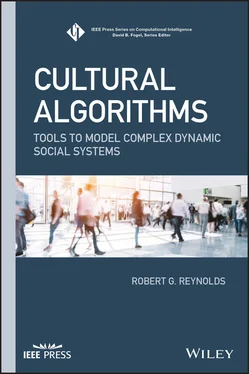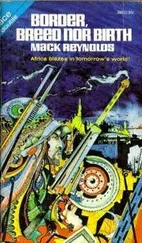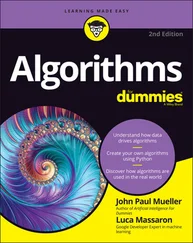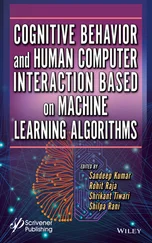Mostafa Z. Ali Department of Computer Information Systems, Jordan University of Science and Technology, Irbid, Jordan
Mohammad I. Daoud Department of Computer Engineering, German Jordanian University, Amman, Jordan
Samuel Dustin Stanley Computer Science Department, Wayne State University, Detroit, MI, USA
Mehdi Kargar Ted Rogers School of Management, Ryerson University, Toronto, ON, Canada
Khalid Kattan Computer Science Department, Wayne State University, Detroit, MI, USA
Leonard Kinnaird-Heether Department of Computer Science, Wayne State University, Detroit, MI, USA
Ziad Kobti School of Computer Science, University of Windsor, Windsor, ON, Canada
Thomas Palazzolo Department of Computer Science, Wayne State University, Detroit, MI, USA
Robert G. Reynolds Department of Computer Science, Wayne State University, Detroit, MI, USA The Museum of Anthropological Archaeology, University of Michigan-Ann Arbor, Ann Arbor, MI, USA
Kalyani Selvarajah School of Computer Science, University of Windsor, Windsor, ON, Canada
Faisal Waris Department of Computer Science, College of Engineering, Wayne State University, Detroit, MI, USA
About the Companion Website
This book is accompanied by a companion website:
www.wiley.com/go/CAT
The website includes:
Supplementary materials
1 System Design Using Cultural Algorithms
Robert G. Reynolds
Computer Science, Wayne State University, Detroit, MI, USA
The Museum of Anthropological Archaeology, University of Michigan‐Ann Arbor, Ann Arbor, MI, USA
By and large, most approaches to machine learning focus on the solution of a specific problem in the context of an existing system. Cultural Algorithmsare a knowledge‐intensive framework that is based on how human cultural systems adjust their structures and contents to address changes in their environments [1]. These changes can produce a solution to the new problem within the existing social framework. Beyond that, the system can adapt its framework in order to produce the solution for a larger class of related problems. Cultural Algorithms are able to mimic this behavior by the self‐adaptation of its’ knowledge and population components.
In other words, we are participating in the Cultural learning process right now. However, as part of the process it is hard to assess what progress, if any, is being made by the system. The Cultural Algorithm provides a framework by which we can step outside of the system so that we can assess its trajectories more clearly. This issue is addressed somewhat by the notion of “human‐centric” learning. However, such an approach suggests that we are ultimately in control of the learning activities. In reality, we are embedded in a performance environment that we have partially created on the one hand, and have been passed down as the result of millions of years of evolution on the other.
The framework for the Cultural Algorithm is given in Figure 1.1. A networked population of agents interact with each other in the population space. The network of agents is termed the social fabric. Agents are connected with each other in the network based on their level of interaction. If the level of interaction between a pair of agents falls below a certain level, that connection can be lost. In that sense, the network is like a piece of cloth where a stress on some portion of the fabric can lead to a disruption or tear in the fabric. Such tears can be mended over time if interactions resume. It is a key feature of Cultural Algorithms since they need to be able to simulate not only the growth but also the decline of social systems [2].
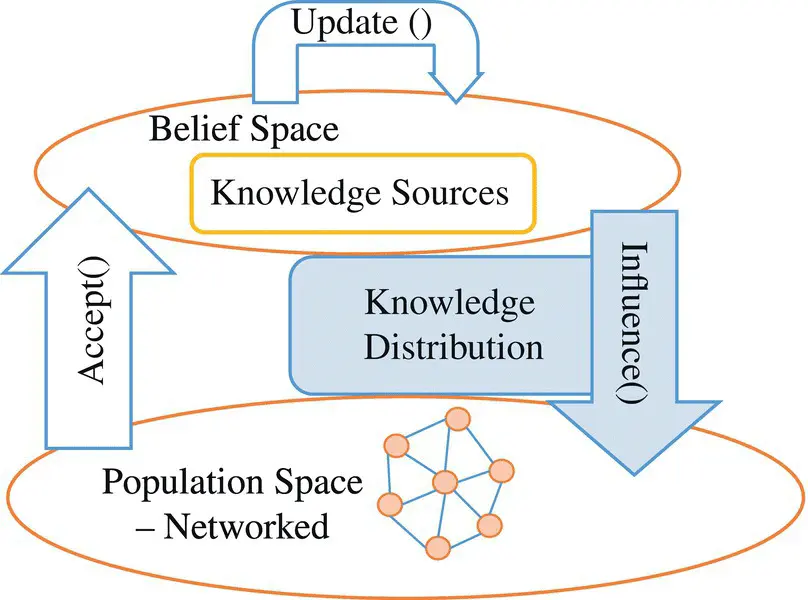
Figure 1.1 Cultural Algorithm framework.
The results of agent interaction within the performance environment in which they are embedded can be accepted into the Belief Space. The Belief Space is a repository of the knowledge acquired by the system so far. It is viewed as a network of different knowledge sources. The accepted knowledge is then integrated into the network through the use of learning procedures that make focused adjustments to the cultural compendium of knowledge. The Information “cloud” can be viewed as the current manifestation of the Belief Space using current technology.
These knowledge sources in the Belief Space can be “active” and or “passive.” Active knowledge sources directly select individuals based on their location and history in the social fabric (network). Passive knowledge sources are selected by individual agents in the network. A knowledge source can be both active and passive. The influence function in a Cultural Algorithm has two stages. In the first stage, each individual is assigned a direct influence, either actively or passively. Next, comes the knowledge distribution stage. Each individual's direct knowledge source is compared with a subset of its neighbors in the network in the knowledge distribution stage. If the knowledge sources are the same, then nothing more needs to be done for an individual. On the other hand, if there is a disagreement, then there is a conflict that needs to be resolved. This conflict is mitigated by a knowledge distribution mechanism. Currently, the mechanisms used are taken from traditional approaches to conflict resolution including drawing straws, majority win, weighted majority, win, various auction mechanisms, and various game frameworks including the Prisoners Dilemma and Stackleberg games. The resultant distribution ranges from static, to moderate, to viral in nature. Individual agents then use their knowledge source(s) to direct their actions in the performance environment. The results of the actions are then sent to the Accept function to decide what will be used to update the Belief Space, and then the cycle continues.
The knowledge sources themselves can support exploitative, exploratory, or stem behaviors. Exploratorymechanisms produce new knowledge about the search space, while exploitativemechanisms focus the search within already discovered regions. A knowledge source that exhibits a “ stem” behavior is one that can either produce exploitative or exploratory behavior dependent on the context. The term itself derives from the biologic notion of “stem cell.” It is a useful transitional device since in the solution of a complex multiphase optimization problem knowledge sources that are useful in one phase may become less useful at the onset of another. The stem knowledge source can help expedite the transition from one set of knowledge sources, say exploitative, that are dominant at the end of one phase to a set that are more useful in the start of the next phase, such as exploratory ones.
This ability to transition from the use of one set of knowledge sources to another as problem dynamics change is one of the key features of cultures in general. The goal of a Cultural System like that of an operating system for a computer is to continue to provide resources for its active agents. The features inherent in the Cultural Algorithm that support this notion of process sustainabilityare as follows:
1 Cultural Algorithms inherently support multiobjective approaches to problem solving. A multiobjective problem is when there is some conflict in an agent's goals, such that the achievement of one goal takes resources away from achieving the other. Since conflicting objectives can reside simultaneously in the Belief Space, agents working on one goal may need to resolve conflicts with agents working on complementary ones. So Cultural Algorithms do not need to be restructured to explicitly deal with multiobjective problems, whereas other machine learning algorithms may need to do so.
Читать дальше
